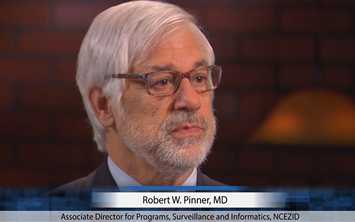NMI Newsroom

- News
- NMI Notes
- eSHARE
- Fact Sheets & FAQs
- Publications & Presentations
- Leadership & Organization
- Videos
CDC Reminds Users About New Online Location for Notifiable Disease Data Coming in November

CDC will provide a new convenient way for users to access notifiable disease data through the National Notifiable Diseases Surveillance System (NNDSS) website in early November. CDC has redesigned the data and statistics section of the NNDSS website to be a one-stop-shop for users to find both detailed information about notifiable disease data and links to the data themselves. Some changes have already been implemented at https://wwwn.cdc.gov/nndss/data-and-statistics.html; complete functionality is expected in November.
This transition will improve the usability, availability, quality, and timeliness of surveillance data as part of the CDC Surveillance Strategy. Although these data will no longer be published in their current format in the Morbidity and Mortality Weekly Report (MMWR), users will be able to easily access the information on the NNDSS website beginning in November. To ease the transition, MMWR also will link users from its website to the new location on the NNDSS website.
Annual Reporting
The August 11, 2017, publication of the MMWR Summary of Notifiable Infectious Diseases and Conditions and MMWR Summary of Notifiable Noninfectious Conditions and Disease Outbreaks was the last time that annual data were published in their current format in MMWR. CDC expects to transition the reporting of NNDSS annual data from MMWR to the NNDSS Data and Statistics webpage in November 2017.
Beginning in November, the redesigned NNDSS Data and Statistics webpage at https://wwwn.cdc.gov/nndss/data-and-statistics.html will contain links to infectious disease data tables that are available in HTML, text, and PDF formats and hosted by the CDC Wide-ranging Online Data for Epidemiologic Research (WONDER) platform. The webpage also will provide links to noninfectious conditions and disease outbreaks surveillance reports published by CDC programs and hosted by WONDER. In addition, the webpage will provide the following resources: documentation for NNDSS infectious diseases and noninfectious conditions and disease outbreaks, such as how the data are collected, reported, and finalized; publication criteria; notes about interpreting data; and the list of notifiable conditions by year.
Weekly Reporting
CDC expects to transition the reporting of NNDSS weekly data in January 2018 and will provide more information later this year.
Consolidating the notifiable disease data on the NNDSS website is part of the NNDSS Modernization Initiative (NMI) strategy to streamline NNDSS and access to data for users; NMI is a component of the CDC Surveillance Strategy. This consolidation of information also is in response to the recommendations of a CDC-wide workgroup (comprising representatives from the CDC Excellence in Science Committee, the Surveillance Science Advisory Group, and MMWR for CDC) to make more data available online and to allow MMWR to focus on publishing scientific and actionable surveillance reports and not routine data tables.
DHIS Staff Members Co-Author Notifiable Infectious and Noninfectious Disease Summaries Published in MMWR

In the August 11, 2017, Morbidity and Mortality Weekly Report (MMWR) publication, DHIS staff members co-authored the “Summary of Notifiable Infectious Diseases and Conditions – United States, 2015” and the “Summary of Notifiable Noninfectious Conditions and Disease Outbreaks: Surveillance Data Published Between April 1, 2016 and January 31, 2017 — United States” These summaries are the product of collaboration among DHIS, CDC disease programs, the MMWR publication team, health jurisdictions who provide the data to CDC, and the Council of State and Territorial Epidemiologists.
The “Summary of Notifiable Infectious Diseases and Conditions — United States, 2015” contains the following:
- official statistics for the reported occurrence of nationally notifiable infectious diseases and conditions in the United States for 2015,
- epidemiologic and prevention information for 2015 for selected infectious diseases and conditions and additional information to aid in the interpretation of surveillance and infectious diseases and conditions trend data,
- a new table displaying the national incidence count and rate for each nationally notifiable disease and condition,
- summary data for selected notifiable infectious diseases and conditions, and
- general and disease-specific references for notifiable infectious diseases and conditions that provide additional information on surveillance and epidemiologic concerns, diagnostic concerns, and infectious disease-control activities.
The full “Summary of Notifiable Infectious Diseases and Conditions — United States, 2015” is available at https://www.cdc.gov/mmwr/volumes/64/wr/mm6453a1.htm?s_cid=mm6453a1_w.
The “Summary of Notifiable Noninfectious Conditions and Disease Outbreaks: Surveillance Data Published Between April 1, 2016 and January 31, 2017 — United States” contains the following:
- a synopsis of major findings from published surveillance reports for nationally notifiable noninfectious conditions and disease outbreaks,
- links to data and tables displaying current and historical descriptive statistics for each condition, and
- highlights of surveillance information on five of nine nationally notifiable noninfectious conditions: cancer, elevated blood lead levels among children aged <5 years, foodborne disease outbreaks, and acute nonoccupational and occupational pesticide-related illness and injury.
“The full Summary of Notifiable Noninfectious Conditions and Disease Outbreaks: Surveillance Data Published Between April 1, 2016 and January 31, 2017 — United States” can be found at https://www.cdc.gov/mmwr/volumes/64/wr/mm6454a1.htm.
Additional information about NNDSS is available at: https://wwwn.cdc.gov/nndss/.
CDC Announces New Online Location for Notifiable Disease Data Coming in November

CDC will provide a new convenient way for users to access notifiable disease data through the National Notifiable Diseases Surveillance System (NNDSS) website in early November. CDC is redesigning the data and statistics section of the NNDSS website to be a one-stop-shop for users to find both detailed information about notifiable disease data and links to the data themselves. This transition will improve the usability, availability, quality, and timeliness of surveillance data as part of the CDC Surveillance Strategy.
Although these data will no longer be published in their current format in the Morbidity and Mortality Weekly Report (MMWR), users will be able to easily access the information on the NNDSS website beginning in November. To ease the transition, MMWR also will link users from its website to the new location on the NNDSS website.
Annual Reporting
The August 11, 2017, publication of the MMWR Summary of Notifiable Infectious Diseases and Conditions and MMWR Summary of Notifiable Noninfectious Conditions and Disease Outbreaks will be the last time that annual data are published in their current format in MMWR. (Please see more information at https://www.cdc.gov/mmwr/publications/index.html). CDC expects to transition the reporting of NNDSS annual data from MMWR to the NNDSS Data and Statistics webpage in November 2017.
Beginning in November, the redesigned NNDSS Data and Statistics webpage at https://wwwn.cdc.gov/nndss/data-and-statistics.html will contain links to infectious disease data tables that are available in HTML, text, and PDF formats and hosted by the CDC Wide-ranging Online Data for Epidemiologic Research (WONDER) platform. The webpage also will provide links to noninfectious conditions and disease outbreaks surveillance reports published by CDC programs and hosted by WONDER. In addition, the webpage will provide the following resources: documentation for NNDSS infectious diseases and noninfectious conditions and disease outbreaks, such as how the data are collected, reported, and finalized; publication criteria; notes about interpreting data; and the list of notifiable conditions by year.
Weekly Reporting
CDC expects to transition the reporting of NNDSS weekly data in January 2018 and will provide more information later this year.
Consolidating the notifiable disease data on the NNDSS website is part of the NNDSS Modernization Initiative (NMI) strategy to streamline NNDSS and access to data for users; NMI is a component of the CDC Surveillance Strategy. This consolidation of information also is in response to the recommendations of a CDC-wide workgroup (comprising representatives from the CDC Excellence in Science Committee, the Surveillance Science Advisory Group, and MMWR for CDC) to make more data available online and to allow MMWR to focus on publishing scientific and actionable surveillance reports and not routine data tables.
NNDSS Modernization Initiative Newsroom Now Features Disease Surveillance Videos

Several videos featuring disease surveillance modernization efforts at CDC and a state public health department are now available in one convenient location on the online newsroom for the National Notifiable Diseases Surveillance System (NNDSS) Modernization Initiative (NMI). CDC will regularly update the new video tab on the NMI Newsroom at https://www.cdc.gov/nmi/newsroom.html#tabs-2-7 with videos related to NMI and other disease surveillance modernization efforts.
Videos currently spotlighted on the NMI Newsroom include the following:
- Conversations on Public Health Surveillance with NNDSS Program Manager Lesliann Helmus and CDC Deputy Director for Public Heath Scientific Services Chesley Richards,
- Modernizing Disease Surveillance in California,
- Moving Forward with NMI (Council of State and Territorial Epidemiologists [CSTE] Annual Conference Presentation), and
- Achieving the Goal of NMI Through Technical Assistance: Improving Public Health Jurisdiction Capacity to Send HL7 Case Notifications (CSTE Annual Conference Presentation).
CDC launched NMI in 2014 as part of the CDC Surveillance Strategy to streamline and standardize notifiable disease data exchange. NMI is focused on reducing the burden on state public health departments sending data to CDC and providing consistent, high-quality, and timely surveillance data to CDC programs to enhance public health decision making.
NMI is led by the Division of Health Informatics and Surveillance in the Center for Surveillance, Epidemiology, and Laboratory Services. It is a close collaboration involving CDC programs, partners at the Association of Public Health Laboratories and CSTE, and state public health departments.
For more information about NMI, please visit the website at https://www.cdc.gov/nmi.
Current Issue of NMI Notes Highlights July eSHARE Webinar on Capturing Industry and Occupation Surveillance Data
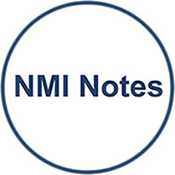
The July issue of NMI Notes highlights an upcoming webinar featuring information for state public health departments on capturing industry and occupation surveillance data. Scheduled for 7/18/17 as part of the National Notifiable Diseases Surveillance System (NNDSS) Modernization Initiative (NMI) eSHARE series, the webinar will include
- a presentation of the new NNDSS HL7 message mapping guide template for states to use to send industry and occupation data to CDC,
- a demonstration by the National Institute for Occupational Safety and Health (NIOSH) providing an overview of the NIOSH Industry & Occupation Computerized Coding System tool, and
- a state public health department’s perspective from the Massachusetts Department of Health on collecting industry and occupation surveillance data.
Access past eSHARE presentations and details about future events at the NMI eSHARE website at http://www.cdc.gov/nmi/eshare.html.
NMI Notes is a monthly news update for public health jurisdictions and external partners about NMI. Readers can learn about the latest updates to the HL7 NNDSS MMGs in development, MVPS, and NMI technical assistance.
NMI Notes is a collaboration by CDC, the Council of State and Territorial Epidemiologists, and the Association of Public Health Laboratories. For all the latest news on NMI, access the full issue of the July NMI Notes at http://www.cdc.gov/nmi/news.html. Subscribe to NMI Notes at http://www.cdc.gov/nmi/news.html.
NNDSS Modernization Initiative Team To Present Several Sessions at 2017 CSTE Annual Conference

The National Notifiable Diseases Surveillance System (NNDSS) Modernization Initiative (NMI) team is scheduled to participate in several sessions at the 2017 Council of State and Territorial Epidemiologists (CSTE) Annual Conference, including a workshop, a breakout session, and two roundtables. This year’s conference is in Boise, Idaho, on June 4–8, 2017.
On Sunday, June 4, 8:00 am–5:00 pm, NMI team members Lesliann Helmus, NNDSS Program Manager, and Michele Hoover, State Implementation and Technical Assistance Lead, along with Division of Health Informatics and Surveillance Director Paula Yoon, will participate in the workshop “Integrating electronic Case Reporting (eCR) at Your Agency: Harvesting the Ripe Fruits of our Labor.” Find more information at http://bit.ly/2pGGgal.
Then, on Tuesday, June 6, the NMI team will participate in three conference sessions: a roundtable for coordinating cooperative agreement investments for surveillance and informatics, breakout session that will provide an update on NMI, and roundtable on NNDSS experiences operationalizing CSTE position statements:
- 7:30–8:15 am: Lesliann Helmus and Michele Hoover, “Coordinating the Public Health Emergency Preparedness (PHEP) Cooperative Agreement with Other CDC Cooperative Agreement Investments in Surveillance and Informatics”; more information at https://cste.confex.com/cste/2017/webprogram/Paper8311.html.
-
10:30 am–12:00 pm:
- Lesliann Helmus: “NMI Progress and Plans”
- Andrew Kuehl, Message Validation, Processing, and Provisioning System (MVPS) Technical Lead: “Enhancements to MVPS”
- Michael Wodajo, NEDSS Base System Program Manager: “Metadata-driven Approach to Creation of HL7-Based Case Notifications for NNDSS”
- Michele Hoover: “Preparing for Onboarding—Lessons Learned from Public Health Jurisdictions Sending HL7 NNDSS Case Notifications”
- More information at https://cste.confex.com/cste/2017/webprogram/Paper8051.html.
- 5:45–6:30 pm: Ruth Jajosky, NNDSS Message Mapping Guide Development Lead; Andreea Bealle, MMG Development Team; and Loretta Foster, MMG Development Team; “From Concept to Reality: Sharing NNDSS Experiences Operationalizing CSTE Position Statements”; more information at https://cste.confex.com/cste/2017/webprogram/Paper7667.html.
NMI is a close collaboration involving CDC programs, partners at the Association of Public Health Laboratories and CSTE, and state public health departments. Additional information about NMI is available on the NMI website at https://www.cdc.gov/nmi/.
NNDSS Modernization Initiative Recognized with 2016 CDC Honor Award

The Division of Health Informatics and Surveillance is pleased to announce that CDC recognized the National Notifiable Diseases Surveillance System (NNDSS) Modernization Initiative (NMI) with a 2016 CDC and ATSDR Honor Award at the 65th annual awards ceremony held on March 28, 2017. NMI was honored in the category of Excellence in Surveillance and Health Monitoring (Domestic).
Known as CDC’s Oscars, the honor awards celebrate and recognize each year groups and individuals who continue to advance CDC’s legacy of improving public health. Since 1952, the agency has formally honored employees for improving agency performance and helping to ensure that staff efforts are not only effective but also as far-reaching as possible.
This year, the NMI team was recognized for their collaboration across public health for updating decades-old systems that receive data for more than 100 health conditions used to monitor disease trends, identify emerging threats, and evaluate public health initiatives. By establishing data standards, automating data transmissions, and combining data streams, NMI reduces the burden on public health departments; improves the completeness, timeliness, and availability of surveillance data for CDC programs; and, ultimately, creates a foundation for public health surveillance systems that will be extensible and responsive for future public health needs.
NMI is a close collaboration involving CDC programs, partners at the Association of Public Health Laboratories and Council of State and Territorial Epidemiologists, and state public health departments. Additional information about NMI is available on the NMI website at https://www.cdc.gov/nmi/.
NMI Opens Up Technical Assistance and Onboarding for Generic v2, Hepatitis, and Arboviral v1.3 to All Public Health Jurisdictions

The CDC National Notifiable Diseases Surveillance System (NNDSS) Modernization Initiative (NMI) team is pleased to announce that, as of 2/6/2017, all public health jurisdictions are invited to begin implementing the new NNDSS HL7 case notification messages for Generic v2, Hepatitis, and Arboviral v1.3. Jurisdictions also may now submit their NMI technical assistance and onboarding requests for implementing these messages.
Pilot jurisdictions should continue to work with the NMI Technical Assistance team to implement case notification messages according to the previously provided schedule. For non-pilot public health jurisdictions, several resources are available to assist them with implementing and onboarding the case notification messages:
- Access the message mapping guides (MMGs) for these conditions and related documentation at the NNDSS HL7 Case Notification Resource Center at https://wwwn.cdc.gov/nndss/case-notification/.
- Check CDC Secure Access Management Services (SAMS) access and, if needed, take the steps necessary to obtain it. More information about SAMS access and training may be found on the NMI web site at https://www.cdc.gov/nmi/ta-sams.html.
- Use METS, available at https://www.cdc.gov/nmi/mets.html, to test developed case notification messages for Generic v2 and hepatitis.
- Use instructions and online technical assistance materials and resources on the new NMI Technical Assistance and Training Resource Center at https://www.cdc.gov/nmi/ta-trc/index.html to develop case notification messages and prepare to onboard messages to CDC.
For jurisdictions implementing Generic v2 and hepatitis messages on their own, when they have completed the necessary pre-onboarding materials and action steps as outlined in the NMI onboarding guide at https://www.cdc.gov/nmi/ta-trc/guidebook-onboarding.html, they may submit onboarding requests to the CDC Electronic Data Exchange Mailbox at edx@cdc.gov with the subject line “[Name of State Public Health Agency] NMI Onboarding Request for [Name of MMG].” The CDC Message Validation, Processing, and Provisioning System (MVPS) will accept Generic v2 and hepatitis data only from jurisdictions who have completed the MVPS onboarding process. The NMI Onboarding team will review requests, clarify as needed, place in a queue as necessary, and provide estimated start dates to the jurisdictions.
For jurisdictions implementing Arboviral v1.3 messages on their own, they may submit onboarding requests to edx@cdc.gov with the subject line “[Name of State Public Health Agency] NMI Onboarding Request for Arboviral v1.3.” The NMI Onboarding team will review requests and contact the jurisdictions to begin onboarding readiness assessments.
Jurisdictions who need technical assistance to implement Generic v2, hepatitis, or Arboviral v1.3 messages may now begin submitting technical assistance requests to edx@cdc.gov with the subject line “NMI Technical Assistance Request.” The NMI Technical Assistance team will review requests, clarify as needed, place in a queue as necessary, and provide estimated start dates to the jurisdictions. While waiting for technical assistance to begin, jurisdictions can get SAMS access, review the MMG(s) they are interested in working on, begin thinking about changes to their surveillance information systems, and line up staff resources to work on the case notification implementation effort.
CDC launched NMI to increase the robustness of the NNDSS technological infrastructure so that it is based on interoperable, standardized data and exchange mechanisms and to enhance the system’s ability to provide more comprehensive, timely, and higher quality data than ever before for public health decision making. NMI opening up technical assistance and onboarding to all jurisdictions for Generic v2, hepatitis, and Arboviral v1.2 case notification implementation is the result of collaboration by teams across CDC and our partners at the Association of Public Health Laboratories (APHL), Council of State and Territorial Epidemiologists (CSTE), and state public health departments.
There are many ways for public health jurisdictions and NMI stakeholders and partners to stay abreast of the latest NMI news. We encourage them to access the following information resources:
- NMI website: https://www.cdc.gov/nmi/index.html,
- NMI Newsroom: https://www.cdc.gov/nmi/newsroom.html,
- NMI Notes monthly newsletter and subscription access: https://www.cdc.gov/nmi/news.html, and
- NMI eSHARE monthly webinar: https://www.cdc.gov/nmi/eshare.html.
Lesliann Helmus Talks Notifiable Disease Surveillance in the Latest Conversation on Public Health Surveillance Video

In the latest installment of the Office of Public Health Scientific Services (OPHSS) Conversations on Public Health Surveillance video series, Lesliann Helmus, MS; National Notifiable Diseases Surveillance System (NNDSS) program manager, DHIS; talks with OPHSS Director Chesley Richards about the current status of and improvements to notifiable disease surveillance. During their chat, Ms. Helmus briefly explained how CDC, public health departments, physicians, partners, and other organizations work together to track diseases and deliver public health data on a national and global level. She gave an overview of notifiable diseases and highlighted how DHIS is using informatics and technology to streamline the transmission of health data to different programs through the NNDSS Modernization Initiative (NMI).
During the conversation with Dr. Richards, Ms. Helmus explained how she became interested in public health surveillance and outlined some of the biggest challenges in data surveillance. Other topics covered in the conversation were
- HL7 message mapping guides and how they are being used to help health departments send data to CDC,
- the new CDC Message Validation, Processing and Provisioning System and how it supports the core functions of receiving, processing, and provisioning data for nationally notifiable diseases, and
- future opportunities to help build state-of-the-art public health surveillance systems.
Ms. Helmus’ conversation with Dr. Richards can be found at https://www.youtube.com/watch?v=Ago4dw3Lex4&index=8&list=PLvrp9iOILTQYLBSxXeQS9OaG50Y2COXNx. For more information on NMI, please visit the website at https://www.cdc.gov/nmi/.
NNDSS Launches New Data and Statistics Webpage

The National Notifiable Diseases Surveillance System (NNDSS) recently launched the new NNDSS Data and Statistics webpage at https://wwwn.cdc.gov/nndss/data-and-statistics.html. The new webpage is a resource for NNDSS data users to help them interpret NNDSS data and determine which data set best meets their needs.
The webpage includes:
- a brief description of provisional and finalized data, along with links to direct readers to locations where these data sets are presented, and
- guides and resources on interpreting data, including
- guide to interpreting provisional and finalized NNDSS data tables,
- historical list of notifiable conditions,
- notification requirements for Nationally Notifiable Conditions,
- Morbidity and Mortality Weekly Report (MMWR) Weeks calendar and fact sheets,
- reporting exceptions and reporting jurisdiction ownership for reporting a case to NNDSS, and
- policies and procedures for timely case notifications.
To learn more information about NNDSS, please visit the NNDSS website at https://wwwn.cdc.gov/nndss/.
CDC Receives First NMI HL7 Case Notification Messages for Generic v2 and Hepatitis Through MVPS

On December 8, 2016, for the first time, the CDC National Notifiable Diseases Surveillance System (NNDSS) began receiving Generic v2 and hepatitis data from a state public health jurisdiction through the new CDC Message Validation, Processing, and Provisioning System (MVPS). Oregon is the first state to begin sending their disease notifications by using the new HL7 Generic v2 and Hepatitis Message Mapping Guides (MMGs) and the first state to have their data received, processed, and provisioned to CDC programs through MVPS. CDC developed these MMGs and MVPS to support public health’s response needs as part of the NNDSS Modernization Initiative (NMI).
CDC receiving, processing, and provisioning Generic v2 and hepatitis data in the new HL7 format through MVPS is the result of collaboration by teams across CDC and our partners at the Association of Public Health Laboratories (APHL), Council of State and Territorial Epidemiologists (CSTE), and state public health departments. These teams defined the needed MMG data elements, developed MVPS, and supported public health jurisdictions in implementing the messages.
The hands-on support provided by the NMI Technical Assistance and Onboarding teams helped Oregon to be the first state to reach this milestone. Over the next few weeks, CDC expects that Michigan, California, Florida, and Minnesota will onboard MVPS and begin sending Generic v2 and hepatitis data, New York will begin sending Generic v2 data, and Idaho will begin sending hepatitis data. More states will continue to onboard MVPS for these conditions into 2017.
CDC launched NMI to increase the robustness of the NNDSS technological infrastructure so that it is based on interoperable, standardized data and exchange mechanisms and to enhance the system’s ability to provide more comprehensive, timely, and higher quality data than ever before for public health decision making. As part of the NMI effort and through collaboration and commitment from subject matter experts across multiple CDC national centers and involvement of jurisdiction partners and other key stakeholders, CDC is developing and adopting new-generation MMGs for HL7 case notifications.
With these guides, CDC will migrate from legacy messaging structures to the widely adopted HL7 standards that provide content standardization and interoperable message exchange structures. In addition to providing core data elements and data exchange formats, these new MMGs will satisfy CDC program requests for disease-specific variables for notifiable conditions. For more information about NMI, please access the NMI website at https://www.cdc.gov/nmi/index.html.
The Message Validation, Processing, and Provisioning System is new CDC-built and operated software that supports the core functions of receiving, processing, and provisioning data for nationally notifiable diseases (NND) based on HL7 standards and new technology. MVPS validates and processes NND HL7 case notification messages sent by public health jurisdictions and provisions the data to CDC programs for their national surveillance efforts. For more information about MVPS, please see the MVPS website at https://www.cdc.gov/nmi/mvps.html.
For more information about the new HL7 Generic v2 and Hepatitis MMGs and related documentation, please access the NNDSS HL7 Case Notification Resource Center at https://wwwn.cdc.gov/nndss/case-notification/message-mapping-guides.html.
For more information about NNDSS, please access the NNDSS website at https://wwwn.cdc.gov/nndss/.
DHIS Launches Message Evaluation and Testing Service
On December 2, 2016, the CDC Division of Health Informatics and Surveillance (DHIS) launched the Message Evaluation and Testing Service (METS). METS is a message validation service for public health jurisdictions to use to validate nationally notifiable disease (NND) HL7 case notification messages before they are sent to the Message Validation, Processing, and Provisioning System (MVPS) for processing and provisioning to CDC programs. Because METS allows jurisdictions to validate HL7 messages against the required messaging, vocabulary, and programmatic standards, METS ensures that high-quality messages are being sent to MVPS.
METS is publically available and may be accessed at https://mets.cdc.gov. For additional information on METS and to access the METS User Guide, please go to the METS webpage at https://www.cdc.gov/nmi/mets.html.
November NMI eSHARE Presentation and Recording Now Posted

The NMI team announces that the presentation and recording from the November 17, 2016, NMI eSHARE presentation have now been posted to the NMI eSHARE website at https://www.cdc.gov/nmi/eshare.html. The November 17 NMI eSHARE session featured an update on the process for Generic v2 and Hepatitis implementation and onboarding.
As a reminder, the next NMI eSHARE will occur in January 2017, and the NMI team will provide more details as they become available. In the meantime, please subscribe to or access our monthly NMI newsletter, NMI Notes, at https://www.cdc.gov/nmi/news.html to stay abreast of all the latest NMI developments.
Comment Period for Draft Rubella and Congenital Rubella Syndrome MMGs Ends November 18
The National Notifiable Diseases Surveillance System (NNDSS) Modernization Initiative team would like to remind local, state, and territorial public health surveillance staff that the open comment period for the Draft Rubella and Congenital Rubella Syndrome Message Mapping Guides (MMGs) ends on November 18, 2016. The open comment period began on October 7, 2016.
Access the guides on the NNDSS HL7 Case Notification Resource Center at https://wwwn.cdc.gov/nndss/case-notification/message-mapping-guides.html. Please send comments using the relevant MMG feedback form through the Electronic Data Exchange mailbox at edx@cdc.gov with the subject line indicating either “Draft Rubella Syndrome MMG Feedback” or “Draft Congenital Rubella Syndrome MMG Feedback.”
The Council of State and Territorial Epidemiologists (CSTE) recently hosted a webinar that provided an overview of the Draft Rubella and Draft Congenital Rubella Syndrome MMGs. The webinar outlined the development process for the guides and gave a high-level overview of the MMGs’ content and layout. The replay of the webinar is available at https://cste.webex.com/cste/lsr.php?RCID=0909b056108d7bc53f24db4347d5e44e.
NMI Highlighted in APHL Lab Matters Article
Winter 2017
“An Informatics Response to a Public Health Emergency”
Presentation from the 2016 America Evaluation Association Annual Conference
October 27, 2016
Using a Mixed Methods Design for Public Health Informatics to Evaluate Capacity and Improve Services
Authors:
- Sebastian Romano, MPH; CDC
- Virginia Dick, PhD; CSTE
- Michele Hoover, MS; CDC
2016 MMWR Weekly infectious disease summary
Vol. 63, No. 54 – October 14, 2016
Summary of Notifiable Infectious Diseases and Conditions — United States, 2014
Adams DA, Thomas KR, Jajosky R, et al.
MMWR Morb Mortal Wkly Rep 2016;63(No. 54).
Health-care providers in the United States are required to report certain infectious diseases to a specified state or local authority. A disease is designated as notifiable if timely information about individual cases is considered necessary for prevention and control of the disease. Each year, CDC publishes a summary of the cases of notifiable disease reported for the most recent year for which data is available. This report presents a summary of notifiable diseases for 2014.
2016 MMWR Weekly noninfectious disease summary
Vol. 63, No. 55 – October 14, 2016
Introduction to the Summary of Notifiable Noninfectious Conditions and Disease Outbreaks — United States
Ralph J. Coates, PhD; Martha Stanbury, MSPH; Ruth Jajosky, DMD; et al.
MMWR Morb Mortal Wkly Rep 2016;63:1–4
The 2016 Summary of Notifiable Noninfectious Conditions and Disease Outbreaks — United States contains official statistics for the occurrence of nationally notifiable noninfectious conditions and disease outbreaks and is published for the second time in the same volume of MMWR as the annual Summary of Notifiable Infectious Diseases and Conditions. The summary includes seven chapters addressing the following subjects: acute pesticide-related illness and injury arising from occupational exposure, acute nonoccupational pesticide-related illness and injury, cancer, elevated blood lead levels among children, elevated blood lead levels among adults, silicosis, and foodborne and waterborne disease outbreaks.
Presentation from the 2016 Public Health Informatics Conference
August 24, 2016
NNDSS Modernization Initiative Update
Authors:
- Lesliann Helmus, MS, CHTS-CP; CDC
- Ruth Jajosky, DMD, MPH; CDC
- Andrew Kuehl, MIT, PMP; CDC
- Michele Hoover, MS; CDC
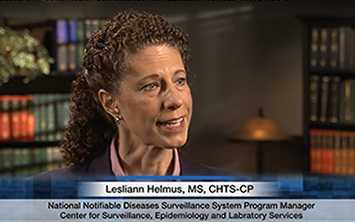
Conversations on public health surveillance with Lesliann Helmus, MS, CHTS-CP
Learn about recent improvements to notifiable disease surveillance at CDC.

Conversations on public health surveillance with Michael F. Iademarco, MD, MPH
Learn about the opportunities and challenges for public health surveillance.

Conversations on public health surveillance with Hillard Weinstock, MD, MPH
Learn why public health surveillance should take advantage of new and emerging technologies.
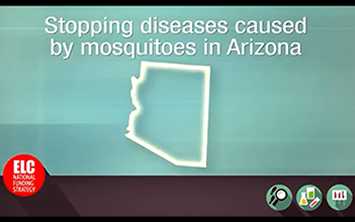
Stopping diseases caused by mosquitoes in Arizona
Learn how the ELC National Funding Strategy is helping public health in Arizona.
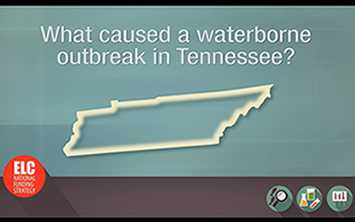
What caused a waterborne outbreak in Tennessee?
Learn how the ELC National Funding Strategy is helping public health in Tennessee.
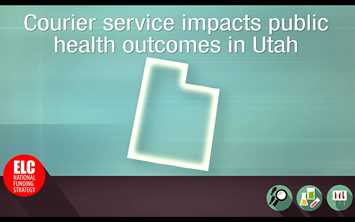
Courier service impacts public health in Utah
Learn how the ELC National Funding Strategy is helping public health in Utah.
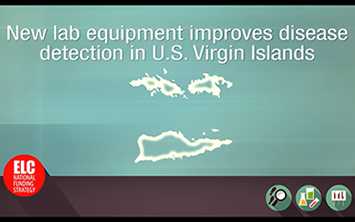
New lab equipment improves disease detection in U.S. Virgin Islands
Learn how the ELC National Funding Strategy is helping public health in U.S. Virgin Islands.
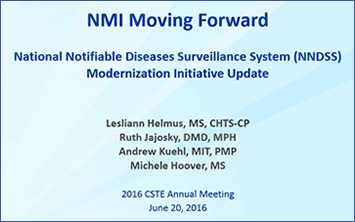
Moving forward with National Notifiable Diseases Surveillance System (NNDSS) Modernization Initiative (NMI)
View the recording from the 2016 CSTE Annual Meeting on the CSTE website.
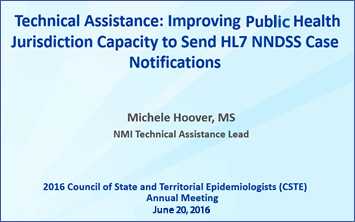
Achieving the goal of NMI through technical assistance: improving public health jurisdiction capacity to send HL7 case notifications
View the recording from the 2016 CSTE Annual Meeting on the CSTE website.
- Page last reviewed: September 28, 2017
- Page last updated: September 28, 2017
- Content source:



 ShareCompartir
ShareCompartir

